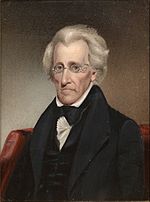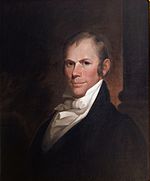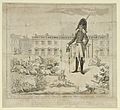United States presidential election, 1824 facts for kids
The United States presidential election of 1824 was a very important election. It was the first time the United States House of Representatives had to choose the president since 1801. John Quincy Adams became the sixth President of the United States.
There were five main candidates for president: John Quincy Adams, John C. Calhoun, William H. Crawford, Henry Clay, and Andrew Jackson. Andrew Jackson was the most popular candidate with the most votes from the public. He also won the most votes in the Electoral College, with 99 votes. Adams was second with 84 votes. Crawford got 41 votes, and Clay got 37 votes.
Because no candidate won more than half of the Electoral College votes, the House of Representatives had to decide. They chose from the top three candidates: Jackson, Adams, and Crawford. In February 1825, Adams won the election by just one vote. John Quincy Adams was the son of John Adams, who was the second U.S. President.
Contents
What Was Happening Before the Election?
By 1824, a time called the Era of Good Feelings was ending. For a while, only one main political party, the Democratic-Republicans, was in charge of American politics. When President James Monroe finished his time in office, he did not pick a favorite person to take his place. This meant many people could try to become president in 1824.
In 1824, America was a republic, but it was still growing as a democracy. People were not as involved in choosing the president as they are today. There were 24 states. In six of them, the state lawmakers chose the president, not the voters. So, a presidential campaign was not just about who was most popular with the public.
Back then, presidential candidates did not travel around and give speeches. Instead, their friends and people who worked for them would put ads in newspapers. These ads would praise their candidate and sometimes criticize their opponents.
In the summer of 1824, some members of Congress met informally. They chose Crawford as their candidate. But other states chose their own candidates. For example, Massachusetts chose Adams, and Kentucky chose Clay. John C. Calhoun decided to run for Vice President instead of president. All four main candidates were from the Democratic-Republican Party. The other main party, the Federalist Party, had almost disappeared.
Who Were the Main Candidates?
After President Madison, three members of his cabinet decided to run for president.
- John Quincy Adams from Massachusetts was the Secretary of State. He was very experienced in foreign policy.
- William H. Crawford from Georgia was the Secretary of the Treasury.
- John C. Calhoun from South Carolina was the Secretary of War.
Henry Clay was also a very important candidate. He was the powerful Speaker of the House of Representatives. He was popular in the western parts of the country.
Andrew Jackson was a famous General and war hero. He was known for winning the Battle of New Orleans in the War of 1812. His soldiers called him "Old Hickory." He was very well-known by the public, even though he had less political experience than the others.
John Quincy Adams
Adams was probably the most qualified person to be president. He was the son of the second president, John Adams. He had studied at Harvard University. He could speak Dutch, French, and German. He had been a U.S. minister (like an ambassador) to other countries. He also helped create the Monroe Doctrine, which was an important foreign policy.
However, Adams was not very good at connecting with people. He was short, bald, and often looked serious. He even said he was "a man of reserved, cold, austere and forbidding manners."
William H. Crawford
Crawford had run for president before in 1816. He had been a U.S. Senator and served in two presidents' cabinets. He believed strongly in states' rights, meaning states should have more power than the federal government. He was against high taxes on imported goods and wanted a small federal government.
Crawford became very sick in 1823 after having a stroke. He was left weak and partly paralyzed. He was even blind in one eye. But he still wanted to run for president.
John C. Calhoun
Calhoun was a strong Democratic-Republican. He was elected to South Carolina's state legislature and then to the U.S. House of Representatives. He became Secretary of War in 1817. He briefly ran for president in 1824 but decided to run for Vice President instead.
Henry Clay
Henry Clay was born in Virginia. He became a lawyer and then moved to Kentucky. He was elected to the Kentucky General Assembly and later to the U.S. House of Representatives. He became Speaker of the House. Clay helped negotiate the peace treaty that ended the War of 1812. He also helped pass the Missouri Compromise in 1820, which was an important agreement about slavery.
Andrew Jackson
General Andrew Jackson was a very strong candidate. He was a hero from the Battle of New Orleans. He had also fought against the Creek Indians. His nickname, "Old Hickory," showed how tough and strong he was. Many people saw him as a political outsider who cared about the common person.
How Were the Election Results Decided?
In 1824, there wasn't just one election day. Throughout the fall, voters cast their ballots. They voted either for individual candidates or for electors who would then vote in the Electoral College. In some states, the state legislatures chose the electors. Some electors promised to vote for a certain candidate, while others did not.
Here are the final results of the popular vote and Electoral College votes:
| Presidential candidate | Party | Home state | Popular vote | Electoral vote | |
|---|---|---|---|---|---|
| Count | Percentage | ||||
| Andrew Jackson | Democratic-Republican | Tennessee | 151,271 | 41.4% | 99 |
| John Quincy Adams | Democratic-Republican | Massachusetts | 113,122 | 30.9% | 84 |
| William Harris Crawford | Democratic-Republican | Georgia | 40,856 | 11.2% | 41 |
| Henry Clay | Democratic-Republican | Kentucky | 47,531 | 13.0% | 37 |
| (Massachusetts unpledged electors) | None | Massachusetts | 6,616 | 1.8% | 0 |
| Other | 6,437 | 1.8% | 0 | ||
| Total | 365,833 | 100.0% | 261 | ||
| Needed to win | 131 | ||||
The House of Representatives Decides
Andrew Jackson won the most popular votes and the most Electoral College votes. But he did not get the 131 electoral votes needed to win the presidency. Because of this, the election went to the House of Representatives. They had to choose from the top three candidates: Jackson, Adams, and Crawford. Henry Clay, who came in fourth, was out of the race.
However, Clay was the Speaker of the House, which gave him a lot of power. He used his influence to support Adams. He also told other members of the House that Jackson was not ready to be president. This happened even though the Kentucky legislature had told Clay to vote for Jackson.
Clay's arguments worked, and Adams was elected president by the House on February 9, 1825. A few days later, Adams chose Clay to be his Secretary of State.
What Happened After the Election?
Jackson and his supporters were very angry. They called the actions of Clay and Adams a "corrupt bargain." They believed that Adams and Clay had made a secret deal. This made many people think the system was unfair and ignored what the voters wanted. Jackson started campaigning for the 1828 election right away. He presented himself as the "champion of the common man."
The 1824 election changed American politics in several ways. It ended the system where members of Congress met in private meetings (called caucuses) to pick presidential candidates. Before 1824, this was how candidates were usually chosen, with little input from voters. But in 1824, most candidates tried to get support directly from the people. This led to a big change. By the 1830s, politics became a topic that interested many people across the country.
The 1824 election also led to the end of the one-party political system. The Democratic-Republicans split into two new parties. Jackson and his followers formed the new Democratic Party. Adams and Clay led the National Republican Party.
Jackson resigned from the Senate and went back to Tennessee. He and his supporters started preparing for his 1828 presidential campaign. His support grew all over the United States. In Congress, Jackson's supporters opposed many of the spending plans Adams tried to pass. Jackson was seen as the hero of everyday people, while Adams was seen as part of a broken political system. Adams did not achieve much during his three years in office. This was partly because of his own personality and partly because Jackson's followers worked against him.
Images for kids
-
Senator Andrew Jackson from Tennessee
-
Secretary of the Navy Smith Thompson
See also
 In Spanish: Elecciones presidenciales de Estados Unidos de 1824 para niños
In Spanish: Elecciones presidenciales de Estados Unidos de 1824 para niños











